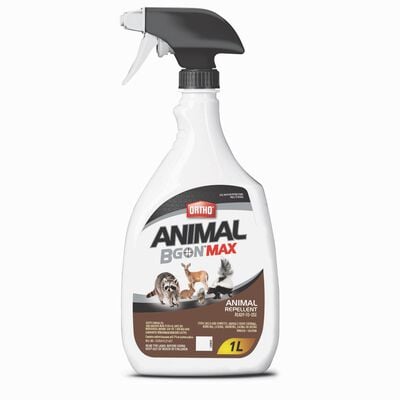
Protect Your Garden & Lawn from Animals
Read about the common animals that damage gardens and landscapes, and how to repel them.
Some animals can damage your plants in your landscapes. You can repel the following animals with Ortho Animal Repellents
Deer
Deer can cause severe damage to gardens in rural and suburban areas. They feed on many vegetables and flowers, stripping off new growth and often eating the entire plant. Deer may also browse on the tender bark, leaves, and twigs of shrubs and trees. Usually they feed on tree buds and bark during the winter or when other sources of food are scarce. The males may damage trees by rubbing their antlers on the trunks and branches. While feeding, they may trample on plants.
Snakes
Garter snakes, sometimes called garden snakes, are common in North America and Central America. At 2-3 feet (60.96-91.44 centimeters) in length, they are small, thin and named for the yellow, white or red stripes that run lengthwise down their backs and are reminiscent of garters. On either side of the stripes are rows of spots in a checkerboard pattern. Garter snakes' bodies are generally black or brown, though they are sometimes green or reddish colored, and their bellies are pale green or yellow. Garter snakes are nicknamed garden snakes because they are commonly found in backyards. They can also be found in forests, wetlands, grasslands, or basking on rocks near a pond or stream, and you might even find several garden snakes hibernating together. They also like to hide under things like rocks and piles of leaves or logs. Most are only active during the daytime unless the weather is very hot, then you may seem them at night. If you try to handle a garden snake, it will probably release a foul-smelling fluid from its tail and may strike at you. Although the toxins in garden snake saliva can be deadly to the snails, salamanders and other animals they eat, they are not dangerous to humans. However, its bite may still cause redness, swelling and discomfort.
Moles
Moles are small (up to 6 inches long) gray to black mammals with fine velvety fur. They have slender, hairless snouts and inconspicuous eyes and ears. Their eyesight is poor, but they have superior senses of smell, touch and hearing. The front feet are much larger than the hind feet and have long, trowel-like claws used for tunneling in the ground. Moles live in burrows made up of many interconnecting runways, usually about 6-8 inches underground. Some species also dig many shallow feeding runways only a few inches below ground, which produces ridges on the soil surface. These ridges are especially noticeable in lawns. Moles dig lateral tunnels to the surface, where they deposit surplus soil in volcano-shaped mounds. Moles seldom feed on plants but do eat slugs, earthworms, grubs, and other small insects. They damage plants by their tunneling, which uproots plants or loosens the soil around roots and causes them to dry out and die.
Voles
Voles do similar damage as mice. Several kinds of voles, confusingly called meadow mice, invade gardens throughout the United States. Voles have blunt noses, thick bodies and short tails. Like field mice, voles live in grassy or brushy areas, nesting underground in shallow burrows with holes 1.5-2 inches wide. They also establish nests above ground in densely vegetated, protected spots, including thick garden hay or leaf mulch. Voles move along narrow runways or tunnels from their nesting areas to their source of food. Voles are active day and night. All year long, voles dig up and feed on seeds, nuts, roots, bulbs, tender vegetables, and flowers. They may severely damage young trees by gnawing on roots and bark, mainly in winter. They are social animals that live together in colonies.
Rabbits
Rabbits are small mammals that live in groups. It is one of the most common pests in urban and suburban areas, but can be found in all habitat types. They can produce 3-4 litters of young per year. They are herbivores that feed by grazing on grass, forbs and leafy weeds. Rabbits graze heavily and rapidly for roughly the first half hour of a grazing period (usually in the late afternoon), followed by about half an hour of more selective feeding.
Groundhogs
Groundhogs are rodents. They are found as far north as Alaska, with their habitat extending southeast to Georgia. Groundhogs are covered with two coats of fur: a dense grey undercoat and a longer coat of banded guard hair that gives the groundhog its distinctive "frosted" appearance. Groundhogs are excellent burrowers, using burrows for sleeping, rearing young, and hibernating. They are one of the few species that enter into true hibernation, and often build a separate winter burrow for this purpose. This burrow is usually in a wooded or brushy area and is dug below the frost line and remains at a stable temperature well above freezing during the winter months. In most areas, groundhogs hibernate from October to March or April, but in more temperate areas, they may hibernate as little as three months. They are mostly herbivores, meaning they will eat wild grasses and other vegetation, including berries and agricultural/garden crops.
Squirrels
Tree squirrels are primarily a problem in lightly wooded or forested rural or suburban areas. These animals establish nests in tree hollows or build nests of leaves, twigs, and bark in trees. They are omnivorous, feeding on fruits, seeds, nuts, insects, and bark. Tree squirrels are agile climbers and jumpers; they can easily jump six feet from the ground to a branch or between branches. These animals damage gardens by digging up newly planted seeds and bulbs and sometimes entire plants. They may also strip the bark or leaves from trees and shrubs and feed on fruits and nuts.
